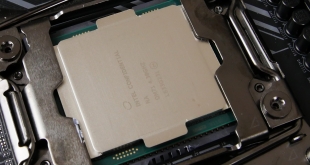
How do you take a High-End Desktop (HEDT) platform laden with six-to-double-digit core count CPUs and make it more appealing to a wider mainstream audience? Add quad-core options, of course. Yes, that’s the utterly bizarre approach that Intel has taken with X299, putting consumers in a position where they can buy a quad-core processor on a platform designed for up to 18-core chips, quad-channel memory, and 28+ PCIe lanes. Adding salt to the wound, many X299 motherboards retail for more than the cost of the 4C8T Core i7-7740X (not to mention the Core i5-7640X!).
Anyway, can Intel’s $339 Core i7-7740X prove itself as a worthy option despite the cost increase of at least £100 over a comparable LGA 1151-based system, the forced obsolescence of numerous X299 platform features, and the removal of a sometimes-convenient integrated GPU for no reduction in purchase price to consumers? Maybe the Core i7-7740X will be aided by the 100MHz uptick in base frequency over the Core i7-7700K, or the increase in TDP, or the native support for DDR4-2666MHz memory.
To summarise briefly, and not waste anybody’s time, the Core i7-7740X is, for all intents and purposes, a Cored i7-7700K re-packaged for Intel’s new HEDT LGA 2066 socket and the X299 platform. There are subtle changes, such as the increase in base clock frequency to 4.3GHz, up from 4.2GHz of the LGA 1151 Core i7-7700K.
The Core i7-7740X also gets a 23% higher TDP rating (112W vs 91W) which may help when maintaining boost frequencies, in which case the Kaby Lake-X chip still tops out at the same 4.5GHz as the Kaby Lake 7700K. Memory support is better for Kaby Lake-X, allowing for DDR4-2666MHz natively, as opposed to DDR4-2400MHz/DDR3L-1600MHz for LGA 1151 Kaby Lake. Not that enthusiasts are likely to care given the proficiency of motherboards in supporting higher memory speeds well into the 3GHz domain.
Oh, and let’s not forget that the integrated HD 630 GPU from the i7-7700K is removed, but not with an accompanying reduction in consumer retail price. The removal of an iGPU on what is a high-end enthusiast CPU is not something that most people would usually care about. However, when that sometimes useful (for troubleshooting, or Quick Sync support for streamers, for example) iGPU is removed and the price is not dropped accordingly, that can easily leave a sour taste in consumers’ mouths. Even a $20-30 decrease in cost would have been a warranted touch that helped to offset the increased X299 platform cost.
The wider picture for the Kaby Lake-X Core i7-7740X, at the moment, looks to be a case of paying the same to get less while also locking into a more expensive platform.
Kaby Lake-X can clearly claim to be a solid stop-gap processor for enthusiasts who wish to upgrade later, perhaps when the 12-18 core CPUs launch, for example. However, a $339 ‘stop-gap’ processor is hardly a disposable asset and the same can be said for the $242 Core i5-7640X. And what happens when the i7-7740X is demoted following its ‘stop-gap’ duty being completed?
The second-hand market for a quad-core CPU on the, eventually, fully-fledged LGA 2066 line-up is likely to be bare of demand. Repurposing the chip will require the purchase of an expensive partnering X299 motherboard, unlike the cheap, bargain-basement LGA 1151 options that a Core i7-7700K could happily sit in. The lack of iGPU also rules out the easy route of putting the processor inside a powerful HTPC or even a home server which can benefit from basic display output capabilities (for the UnRaid GUI, for example).
Compare that to the Core i7-7700K and its cheaper platform cost (significantly cheaper when factoring in non-overclocking chipset motherboards) and the set of options following its retirement is far greater.
We would even argue that the 6C12T Skylake-X i7-7800X is a far better choice as a ‘stop-gap’ solution for $50 more than the i7-7740X. If you’re upgrading to a higher-core-count Skylake-X model in the future, the six cores of the 7800X are likely to be useable to you now, despite its reduction in headline (and probably overclockable) frequencies.
| CPU | Intel Core i7 7740X | Intel Core i7 7700K | Intel Core i7 7800X | Intel Core i9 7900X | AMD Ryzen 7 1800X | AMD Ryzen 7 1700 |
| CPU Codename | Kaby Lake-X | Kaby Lake | Skylake-X | Skylake-X | Zen | Zen |
| Core / Threads |
4 / 8 | 4 / 8 | 6 / 12 | 10 / 20 | 8 / 16 | 8 / 16 |
| Base Frequency | 4.3GHz | 4.2GHz | 3.5GHz | 3.3GHz | 3.6GHz | 3.0GHz |
| Boost Frequency | 4.5GHz | 4.5GHz | 4.0GHz | 4.3GHz | 4.0GHz | 3.7GHz |
| Maximum Frequency (XFR / TBM 3.0) |
n/a | n/a | n/a | 4.5GHz (TBM 3.0) | 4.1GHz (XFR) | 3.75GHz (XFR) |
| Unlocked Core Multiplier | Yes (x1 granularity) | Yes (x1 granularity) | Yes (x1 granularity) | Yes (x1 granularity) | Yes (x0.25 granularity) | Yes (x0.25 granularity) |
| L3 Cache | 8MB | 8MB | 8.25MB | 13.75MB | 16MB | 16MB |
| Max. Memory Channels |
2 (DDR4) | 2 (DDR4 & DDR3L) | 4 (DDR4) | 4 (DDR4) | 2 (DDR4) | 2 (DDR4) |
| Max. Memory Frequency (Native) |
2666MHz | 2400MHz / 1600MHz | 2400MHz | 2666MHz | 1866 to 2667MHz | 1866 to 2667MHz |
| PCIe Lanes | 16 | 16 | 28 | 44 | 16+4+4 | 16+4+4 |
| CPU Socket | LGA 2066 | LGA 1151 | LGA 2066 | LGA 2066 | AM4 | AM4 |
| Manufacturing Process | 14nm | 14nm | 14nm | 14nm | 14nm | 14nm |
| TDP | 112W | 91W | 140W | 140W | 95W | 65W |
| MSRP | $339 | $339-350 | $389 | $999 | $499 | $329 |
| UK Street Price (June 2017) |
Approx. £320 | Approx. £320 | Approx. £360 | Approx. £950 | Approx. £450 | Approx. £300 |
Overclocking is clearly an area where Kaby Lake-X looks to make sense. Intel has placed the 4C8T Kaby Lake-based chip, blessed with the company’s most modern refined 14nm process technology, on the LGA 2066 socket. That allows it to leverage the higher-performance power delivery solutions on X299 motherboards which is likely to aid the CPU’s overclocking capability. Definitely a tick in the correct box for enthusiasts who care about nothing other than all-out frequency, no matter how the value perspective looks.
There are also prosumers with workloads who need blazing-fast speed on a relatively small number of cores, be it due to poor multi-threading of their software or per-core licensing fees, and will pay up for that privilege. High-frequency traders or perhaps engineers using old, poorly-threaded software packages, which I was unfortunate enough to encounter somewhat frequently during my time at university, spring to mind.
That’s not to say that Kaby Lake-X will find itself in the latest City high-rises dealing with fraction-of-a-second movements on the stock markets. However, to home enthusiasts who dabble in some of the aforementioned use cases, be it for education or other means, Kaby Lake-X may have gained their attention.
That’s enough of an introduction for Kaby Lake-X and the Core i7-7740X. Let’s see how it performs. First stop, the overclocking results.
Our objective with CPU overclocking is to hit frequencies that we think will be achievable for daily use by the platform’s buyers. As such, we test with sensible cooling hardware in the Corsair H110i GT 280mm AIO. We also used sensible voltages that lead to manageable thermal results.
Stability is confirmed by running multiple Cinebench tests, Handbrake video conversion, and AIDA64 CPU, FPU, and Cache stress test for at least 1 hour. We do not use Prime95 as we have found it to be overly demanding as a stress test application with the more recent AVX-capable versions.
The partnering hardware of choice is the ASUS X299-Deluxe motherboard, 16GB of G.SKILL TridentZ 3200MHz CL14 DDR4, and a Seasonic 760W Platinum PSU. We chose the ASUS motherboard due to its strong power delivery system based around International Rectifiers MOSFETs.
That added 4-pin power connector gives extra peace of mind when overclocking the very power-hungry Skylake-X CPUs but is not really necessary for Kaby Lake-X overclocking (outside of LN2 extreme OC). We also point a 100mm Antec Spot Cool at the VRM heatsink to provide direct airflow for cooling.
Overclocking with the Kaby Lake-X Core i7-7740X is very rewarding. We were able to hit 5.0GHz very easily with minimal adjustment to the system – we simply applied 1.25V VCore in the UEFI and opted for the Level 3 LLC setting.
Jumping up to 5.1GHz saw us needing 1.30V in the UEFI for stability. We also opted to change the LLC mode to Level 1 but we were unable to validate actual load voltages due to current software reading errors and the ASUS board’s lack of voltage check points. The system was stable with these settings and temperatures were in check using the Corsair H110i GT 280mm AIO cooler.
In short, our final Core i7-7740X overclocking settings using an ASUS X299-Deluxe motherboard were:
- 5.1GHz on all cores.
- 1.30V CPU VCore (in the UEFI).
- Level 1 LLC (around 1.24V AIDA 64 load VCore in OS, according to software readings).
- Multiple Cinebench R15 multi-core runs to validate stability, as well as AIDA64 CPU stress test.
- DDR4-3200MHz 14-14-14-34 @ 1.35V.
Overclocking comments:
Our overclocking results with the Core i7-7740X were positive, hitting 5.1GHz on all cores while maintaining sensible temperature levels. If you are happy pushing the voltage further, it is likely that 5.2GHz will be achievable, provided you can cool the chip.
The overclocking performance looks to be around 100-400MHz better than that of a Core i7-7700K in general. Our specific Core i7-7700K is perfectly stable at a conservative 4.8GHz with 1.31-1.35V and we have seen many 7700K users push their chips to 4.9GHz and 5.0GHz with appropriate cooling.
Core i7-7740X delivers in terms of overclocking results and is likely to be even more overclockable if you decide to delid the chip and replace its TIM with a higher-quality solution.
We will be outlining the Core i7-7740X CPU's performance while using an ASUS X299-Deluxe LGA 2066 motherboard. A 16GB (2x8GB) kit of G.Skill's 3200MHz CL14 DDR4 memory serves our test system.
Today's comparison processors come in the form of:
- Broadwell-E i7-6800K (6C12T) and i7-6950X (10C20T).
- Kaby Lake's i7-7700K (4C8T).
- Ryzen 7's 1700 (8C16T) and 1800X (8C16T).
- Ryzen 5's 1600X (6C12T).
- Skylake-X i9-7900X (10C20T).
Each processor is tested at its default out-of-the-box settings and when overclocked to a reasonable level. For the Intel CPUs, we ensured that forced-turbo was disabled so that Intel's defined Turbo Boost parameters were functioning correctly. As such, all-core load frequencies for the tested chips are as follows:
- Core i7-7740X = 4.5GHz.
- Core i9-7900X = 4.0GHz (most of the time, with Handbrake or synthetic stress tests as an exception).
- Core i7-6950X = 3.4GHz (most of the time, with Handbrake or synthetic stress tests as an exception).
- Core i7-6800K = 3.5GHz.
- Core i7-7700K = 4.4GHz.
- Ryzen 7 1800X = 3.7GHz.
- Ryzen 7 1700 = 3.2GHz.
- Ryzen 5 1600X = 3.7GHz.
CPU Test System Common Components:
- Graphics Card: Nvidia GeForce GTX 1080 Ti Founders Edition (custom fan curve to eliminate thermal throttling).
- CPU Cooler: Noctua NH-D15 & Corsair H110i GT.
- Games SSD: SK hynix SE3010 SATA 6Gbps 960GB.
- Power Supply: Seasonic Platinum 760W.
- Operating System: Windows 10 Pro 64-bit (Creators Edition).
Skylake-X LGA 2066 System (i7-7740X, i9-7900X):
- 7740X CPU: Intel Core i7 7740X ‘Kaby Lake-X' (ES) 4 cores, 8 threads (5.1GHz @ 1.30V overclocked).
- 7900X CPU: Intel Core i9 7900X ‘Skylake-X' (ES) 10 cores, 20 threads (4.6GHz @ 1.20V overclocked).
- Motherboard: ASUS X299-Deluxe (LGA 2066, X299).
- Memory: 16GB (2x8GB) or 32GB (4x8GB) G.Skill Trident Z 3200MHz 14-14-14-34 DDR4 @ 1.35V.
- System Drive: Samsung 840 500GB.
Ryzen AM4 System (Ryzen 5 1600X, Ryzen 7 1700, Ryzen 7 1800X):
- 1800X CPU: AMD Ryzen 7 1800X ‘Summit Ridge' 8 cores, 16 threads (4.05GHz @ 1.425V overclocked).
- 1700 CPU: AMD Ryzen 7 1700 ‘Summit Ridge' 8 cores, 16 threads.
- 1600X CPU: AMD Ryzen 5 1600X ‘Summit Ridge' 6 cores, 12 threads (4.0GHz @ 1.4125V overclocked).
- Motherboard: Gigabyte Aorus AX370-Gaming 5 & ASUS Crosshair VI Hero (AM4, X370, AGESA 1006).
- Memory: 16GB (2x8GB) G.Skill FlareX 3200MHz 14-14-14-34 DDR4 @ 1.35V.
- System Drive: SanDisk Ultra Plus 256GB.
Kaby Lake LGA 1151 System (i7-7700K):
- 7700K CPU: Intel Core i7-7700K ‘Kaby Lake' (Retail) 4 cores, 8 threads (4.8GHz @ 1.35V overclocked).
- Motherboard: ASUS Maximus VIII Hero (LGA 1151, Z170).
- Memory: 16GB (2x8GB) G.Skill FlareX 3200MHz 14-14-14-34 DDR4 @ 1.35V.
- System Drive: Micron M600 256GB.
Broadwell-E LGA 2011-3 System (i7-6800K, i7-6950X):
- 6800K CPU: Intel Core i7 6800K ‘Broadwell-E' (Retail) 6 cores, 12 threads (4.2GHz @ 1.275V overclocked).
- 6950X CPU: Intel Core i7 6950X ‘Broadwell-E' (Retail) 10 cores, 20 threads (4.2GHz @ 1.275V overclocked).
- Motherboard: ASUS ROG Strix X99 Gaming (LGA 2011-v3, X99).
- Memory: 32GB (4x8GB) G.Skill Trident Z 3200MHz 14-14-14-34 DDR4 @ 1.35V (at 3000MHz for the 6800K due to IMC weakness).
- System Drive: Kingston HyperX 3K 120GB.
Software:
- ASUS X299-Deluxe BIOS v0501 (pre-release).
- GeForce 382.33 VGA drivers.
Tests:
Productivity-related:
- Cinebench R15 – All-core & single-core CPU benchmark (CPU)
- HandBrake – Convert 6.27GB 4K video recording using the Normal Profile setting and MP4 container (CPU)
- Mozilla Kraken – Browser-based JavaScript benchmark (CPU)
- x265 Benchmark – 1080p H.265/HEVC encoding benchmark (CPU)
- 7-Zip – Built-in 7-Zip benchmark test (CPU & Memory)
- SiSoft Sandra – Memory bandwidth (Memory)
Gaming-related:
- 3DMark Time Spy – Time Spy (DX12) test (Gaming)
- Ashes of the Singularity Escalation – Built-in benchmark tool CPU-Focused test, 1920 x 1080, Extreme quality preset, DX12 version (Gaming)
- Ghost Recon: Wildlands – Built-in benchmark tool, 1920 x 1080, Very High quality preset, DX12 (Gaming)
- Grand Theft Auto V – Built-in benchmark tool, 1920 x 1080, Maximum quality settings, Maximum Advanced Graphics, DX11 (Gaming)
- Metro: Last Light Redux – Built-in benchmark tool, 1920 x 1080, Very High quality settings, SSAA Enabled, AF 16X, High Tessellation, DX11 (Gaming)
- Total War Warhammer – Built-in benchmark tool, 1920 x 1080, Ultra quality preset, DX12 version (Gaming)
Cinebench
Cinebench is an application which renders a photorealistic 3D scene to benchmark a computer’s rendering performance, on one CPU core, all CPU cores or using the GPU. We run the test using the all-core CPU and single-thread CPU modes.
Handbrake Conversion
Handbrake is a free and open-source video transcoding tool that can be used to convert video files between different codecs, formats and resolutions. We measured the average frame rate achieved for a task of converting a 6.27GB 4K video using the Normal Profile setting and MP4 container. The test stresses all CPU cores to 100% and shows an affinity for memory bandwidth.
x265 Encoding
x265 Encoding tests system performance by encoding a 1080p test file using the x265/HEVC format.
Overview:
The Core i7-7740X's performance in our CPU-heavy, multi-threaded benchmarks is unsurprising. A slight frequency bump over the 4C8T 7700K allows the 7740X to offer slight performance improvements in all circumstances (1.9% in Cinebench, 1.5% in Handbrake, and 2.4% in x265 encoding). However, compared to the similarly-priced Ryzen 7 1700, Intel's quad-core processor is well-and-truly beaten when focussing on multi-threaded performance.
Single-core performance is a clear strength for the 7740X thanks to its Skylake-based microarchitecture and very high operating frequencies. When overclocked to 5.1GHz, the quad-core Kaby Lake-X i7 establishes a very comfortable lead in the Cinebench single-threaded test.
Looking at comparative performance, the Ryzen 7 1700 is 45% faster than the stock-clocked 7740X in Cinebench, 27% quicker in Handbrake, and 17% better in x265 encoding. However, the stock 7740X is 33% higher performance than the Ryzen 7 1700 in Cinebench single-threaded. The Kaby Lake-X i7 puts up a better fight against the six-core Broadwell-E i7-6800K thanks to the latter's significant frequency disadvantage.
7-Zip
7-Zip is an open source Windows utility for manipulating archives. We measure the Total Rating performance using the built-in benchmark tool. The test stresses all CPU cores to 100% and shows an affinity for memory bandwidth.
Mozilla Kraken
Mozilla Kraken is a browser-based JavaScript benchmark that tests a variety of real-world use cases. We use Chrome as the test browser. The test exhibits very little multi-threading and shows an affinity for CPU clock speed and IPC.
Sandra Memory Bandwidth
Overview:
7-Zip is well multi-threaded and therefore the Ryzen 7 1700 hands the stock-clocked i7-7740X a strong beating in that test, outperforming Intel's chip by 31%. Intel, however, has the advantage when it comes to Mozilla Kraken performance thanks to the fast operating frequency and well-built microarchitecture being far more important than core count.
Compared to the Core i7-7700K, Intel's new Kaby Lake-X chip is marginally faster thanks to its 100MHz frequency advantage. Turning on the afterburners and overclocking the 7740X to 5.1GHz, however, yields strong results in the 7-Zip benchmark and chart-topping performance Mozilla Kraken.
Intel's dual-channel Core i7s trail Ryzen in terms of memory bandwidth. An even greater performance deficit is shown against the quad-channel Intel HEDT processors. Kaby Lake-X is not the best choice if memory bandwidth is important. However, an AIDA64 latency score of 42.9ns, versus 73.5ns for the Ryzen 7 1700, shows where the dual-channel Core i7s perform well.
3DMark
3DMark is a multi-platform hardware benchmark designed to test varying resolutions and detail levels of 3D gaming performance. We run the Windows platform test and in particular the Fire Strike benchmark, which is indicative of high-end 1080p PC Gaming. We also test using the Time Spy benchmark which gives an indication of DirectX 12 performance.
Grand Theft Auto V
Grand Theft Auto V remains an immensely popular game for PC gamers and as such retains its place in our test suite. The well-designed game engine is capable of providing heavy stress to a number of system components, including the GPU, CPU, and Memory, and can highlight performance differences between motherboards.
We run the built-in benchmark using a 1080p resolution and generally Maximum quality settings (including Advanced Graphics).
Metro: Last Light Redux
Despite its age, Metro: Last Light Redux remains a punishing title for modern computer hardware. We use the game's built-in benchmark with quality set to Very High, SSAA enabled, AF 16X, and High tessellation.
Gaming Performance Overview:
Gaming performance is where the Core i7-7740X sets the playing field alight, just as its mainstream 7700K cousin did. Kaby Lake with high clock speeds is the recipe for chart-topping gaming performance numbers.
3DMark is well multi-threaded and therefore does not reward the 7740X's significant clock speed. GTA V and Metro: Last Light, both of which like clock frequency and, especially in GTA's case, core count, show superb performance with the Kaby Lake-X Core i7. Overclocking to 5.1GHz firmly positions the 7740X at the top of both gaming charts, with the next closest competitor being our lower-clocked 7700K.
Compared to the Ryzen 7 offerings, the Core i7-7740X destroys all of AMD's options when it comes to performance in GTA V (which is known to favour Intel hardware) in a way that will be important to high refresh rate gamers. Of course, the trade-off is a severely diminished amount of spare CPU resources for operations such as streaming whilst gaming, if that is important to you.
Ashes of the Singularity Escalation
Ashes of the Singularity Escalation is a Sci-Fi real-time strategy game built for the PC platform. The game includes a built-in benchmark tool with DirectX 12 support. We run the CPU-focused benchmark using DirectX 12, a 1080p resolution and the Extreme quality preset.
Ghost Recon Wildlands
Tom Clancy’s Ghost Recon Wildlands is an open world tactical shooter video game developed by Ubisoft Paris. It is the tenth instalment in the Tom Clancy’s Ghost Recon franchise and is the first Ghost Recon game to feature an open world environment.
We run the built-in benchmark using a 1080P resolution and the Very High quality preset.
Total War: Warhammer
Total War: Warhammer is another title which features both DX11 and DX12 modes. Heavy loading can be placed on the CPU using the built-in benchmark. The DX12 mode is poorly optimised and tries to force data through a low number of CPU threads rather than balance operations across multiple cores. As such, this gives a good look at pure gaming performance of each CPU in titles that aren't well multi-threaded.
We run the built-in benchmark using the DirectX 12 mode, a 1080p resolution, and the Ultra quality preset.
Gaming Performance Overview:
Despite being heavily multi-threaded, Ashes of the Singularity Escalation positions the Core i7-7740X in a favourable position against AMD Ryzen competitors. The Kaby Lake-X CPU's performance is very similar to that of the Kaby Lake i7-7700K, unsurprisingly.
Ghost Recon: Wildlands and Total War: Warhammer both spring the 7740X to the top of the charts. Ghost Recon is well multi-threaded but still benefits from the Kaby Lake-X CPU's high clock speed. Even in its DX12 mode, Total War shoves data through a small number of threads, pinning one of them at 100% usage, and therefore becomes a race for clock speed and a strong, balanced architecture.
Gaming performance in DX12 titles is very strong with the Core i7-7740X. However, it is not significantly different to the performance shown by the 7700K and the only gaps will be driven by overclocking capacity on either CPU.
The market for people buying an expensive CPU and using it for gaming at 1080p is likely to be very slim. What 1080p does is give a good indication of the CPU's raw gaming performance as GPU power is sufficient to push frame rates to a level where the CPU and memory limitations can be observed.
We supplement the 1080p gaming results with a pair of games tested at 1440P and 4K. We chose Ghost Recon Wildlands and GTA V as they are computationally-heavy, open-world games with good built-in benchmarks.
Ghost Recon Wildlands
We run the built-in benchmark using a 1440P and 4K resolution and the same settings as the 1080p test (Very High preset).
Grand Theft Auto V
We run the built-in benchmark using a 1440P and 4K resolution and the same settings as the 1080p test (generally Maximum quality settings including Advanced Graphics).
1440P and 4K Gaming Performance Overview:
Even with the resolutions increased, the Kaby Lake and Kaby Lake-X Core i7 CPUs maintain their positions atop the charts. If you are a high-resolution gamer, the Core i7-7740X is a good CPU for your system. However, it does not offer a noticeable performance advantage over the i7-7700K and its cheaper LGA 1151 platform.
4K60 gamers are spoilt with choice when it comes to purchasing a CPU. There's little performance difference between all of the chips on display at this resolution where GPU horsepower is in high demand. Kaby Lake-X is up there amongst the fastest options at 4K but it isn't necessarily the best choice if you also want to stream gameplay at the same time.
We leave the system to idle on the Windows 10 desktop for 5 minutes before taking a power draw reading. For CPU load results, we read the power draw while producing five runs of the Cinebench multi-threaded test as we have found it to push power draw and temperature levels beyond those of AIDA 64 and close to Prime 95 (non-AVX) levels. Even five continuous loops of Cinebench results in a short run time on high-performance CPUs which influences the validity of the temperature reading, so we run 5 minutes of AIDA64 stress test to validate data.
The power consumption of our entire test system (at the wall) is shown in the chart. The same test parameters were used for temperature readings.
Power Consumption
Power draw readings are accurate to around +/-5-10W under heavy load due to instantaneous fluctuations in the value. We use a Platinum-rated Seasonic 760W PSU (with 8-pin plus 4-pin power connectors where possible) and install a GTX 1070 video card that uses very little power.
Power consumption from the four-core, eight-thread i7-7740X is reasonable at less than 150W system-wide whilst rendering in Cinebench R15. The Kaby Lake-X system demands around 10% more power than its Kaby Lake 7700K alternative and this is most likely down to the CPU as both test motherboards were models from ASUS.
AMD's Ryzen 7 1700 is close to the 7740X when looking at system power draw during Cinebench. This speaks volumes for the efficiency of AMD's Zen architecture at the moderate operating speeds of the eight-core, sixteen-thread Ryzen 7 1700.
Overclocked to 5.1GHz, the 7740X system pushes slightly past 180W from the wall when loaded. This still makes it less power hungry than the six-core 6800K system or an eight-core Ryzen 7 1800X-based system, for example. There are no PSU-busting numbers on display from the Kaby Lake-X 7740X.
Cinebench-led performance efficiency for the Core i7-7740X is poor. This is because the four-core chip is, in essence, heavily overclocked from the factory. Rendering efficiency in Cinebench scales better with a larger number of lower-clocked cores which will typically demand less power consumption.
If you are concerned about getting the best productivity performance per unit energy, the Core i7-7740X is not the CPU to purchase, based on our Cinebench-led numbers. AMD's similarly-priced Ryzen 7 1700 would take that crown.
Temperatures
Temperature recordings were taken using a 280mm Corsair H110i GT all-in-one liquid cooler with its two fans running at full speed (around 2300 RPM). Ambient temperatures were held around 23°C (and normalised to 23°C where there were slight fluctuations).
We read the Tdie temperature for Ryzen which accounts for the 20°C temperature offset. The charted temperatures are without the 20°C offset added on. Ryzen idle temperatures are omitted due to inaccurate readings caused by sensor drift. Ryzen 7 1700 temperature data is omitted as the numbers are incorrect (sometimes sub-ambient).
Thermal performance from the 7740X seems to be slightly better than that of the 7700K in general. One of the reasons for this slight improvement, despite both chips using TIM under the heatspreader and not solder, is due to the significantly larger surface area of the LGA 2066 i7-7740X's heatspreader.
With that said, temperatures are still higher than we would like to see for a quad-core CPU and this is due to the use of TIM. At stock clocks, the i7-7740X runs at 54°C in Cinebench which is hotter than a Ryzen 5 1600X, Ryzen 7 1800X, Core i7-6800K, and Core i7-6950X, all of which offer significantly higher performance in that same benchmark and consumer more power.
Throw overclocking into the picture, and the Kaby Lake-X 7740X is practically the joint-second hottest processor that we have tested. Only the 10-core i9-7900X runs significantly warmer when overclocked. That's not a place on the chart where a four-core processor should be sitting, even after its very high operating frequency of 5.1GHz is accounted for. The power being pushed through the quad-core i7 processors simply does not warrant such elevated temperatures.
Clearly there are still thermal barriers that need to be fixed with Intel's heatspreader design before we can consider this as a superb option for overclocking users. De-lidding is an option but not everybody is comfortable with voiding the warranty on a $339 CPU or risking damaging their expensive new chip.
There's no denying that Intel's Kaby Lake-X Core i7-7740X is an ultra-fast processor in lightly-threaded applications that can be overclocked to a dizzying 5GHz+ with ease. Gaming performance is superb thanks to the Kaby Lake-X processor's 4.5GHz operating frequency out-of-the-box.
With that said, performance in multi-threaded applications is severely lacking to the competition even from Intel's own product stack. The similarly-priced 8C16T AMD Ryzen 7 1700 blasts past the 4C8T 7740X in workloads that scale with thread count, while Intel's own six-core options also hand the Kaby Lake-X quad-core a solid beating in most productivity scenarios.
There are instances where the Core i7's fast out-of-the-box and overclocked operating frequencies more than make up for its thread count deficit. These instances primarily revolve around gaming, where the common notion that a fast quad-core processor is the best option still seems to be true. Of course, that's if you don't plan to heavily leverage spare CPU resources, or the lack thereof in most cases for the 7740X, for streaming.
Value is where the Core i7-7740X really falls short. To be perfectly blunt, this CPU is basically a Core i7-7700K with the iGPU chopped off, slightly better overclocking capacity, and a higher TDP rating. In isolation, those points are nothing that will deter enthusiasts. However, the fact that Intel charges the same price for a 7700K without the iGPU is a sour pill to swallow.
More importantly, the value perspective is destroyed when factoring in the expensive LGA 2066 package and accompanying X299 platform. With budget LGA 2066 (X299) motherboards starting at £220, the 7740X is a far greater platform investment than the Core i7-7700K and its £110 Z270 motherboards or £50 bargain basement LGA 1151 options. Kaby Lake-X forces you to pay more for an X299 motherboard with features that are instantly disabled the moment you insert the processor. Hardly a smart value option.
Perhaps one of the few user bases that will see Kaby Lake-X as a reasonable value option are those who plan to upgrade to higher core count chips when they are released. However, the second-hand market demand for the 7740X is likely to be limited due to expensive motherboards, the chip is less versatile than the 7700K due to the latter's iGPU and cheaper platform, and users with workloads that warrant a 12-18 core CPU in a few months are better served by the £50 more expensive six-core i7-7800X now (or waiting to see what AMD Threadripper brings to the table).
The other type of user that will see value in Kaby Lake-X is somebody who simply wants all-out frequency from the Core i7 CPU. Enthusiast overclockers who do not care for core count, for example. Gamers who want the 100-400MHz more that the 7740X may offer over the 7700K, and will pay up for it also fall into this category. As do prosumers whose workloads scale with frequency rather than a thread count higher than eight.
To summarise, there are use cases for the Kaby Lake-X Core i7-7740X but they are, in general, hard to justify or reserved for a niche audience. Thermal results are also poor and performance efficiency is lacking compared to Ryzen or Broadwell-E when it comes to multi-threaded workloads. However, gaming performance is as good as we have come to expect from Kaby Lake-based options and the overclocking ability of the 7740X is tremendous.
The Intel Core i7-7740X is available for £319.99 (at the time of writing) from Overclockers UK.
Discuss on our Facebook page HERE.
Pros:
- Superb gaming performance thanks to fast clock speeds.
- Excellent overclocking capacity aided by strong X299 VRM solutions and a larger package.
- A solid option when all-out frequency is more important than core counts past four.
- Gives purchasers strong upgrade routes without switching motherboards.
Cons:
- Poor thermal performance.
- Power efficiency is lacking, especially in comparison to Ryzen or Broadwell-E.
- Multi-threaded performance leaves plenty to be desired on a ‘High-end Desktop' product.
- Poor value compared to the Core i7-7700K which offers an iGPU for the same price.
- Terrible value compared to the 7700K-capable LGA 1151 platform which offers practically identical performance.
- Cripples a vast number of features on X299 motherboards.
- The 6C12T, highly-clocked Core i7-7800X is only $50 (15%) more expensive, if X299 is a must.
KitGuru says: An ultra-fast gaming CPU with superb overclocking capacity, as we would expect from a chip that is, more-or-less, a re-packaged Core i7-7700K with some adjustments. However, the value perspective of the Core i7-7740X is awful and the chip makes little sense on Intel's HEDT platform when the mainstream Core i7-7700K and six-core i7-7800X both exist. Perhaps worth a second look to those with intentions of upgrading to the 12-18 core parts, or enthusiasts who want all-out frequency when overclocking. Otherwise, just buy the Core i7-7700K or alternative Ryzen 7 options and put the £100+ saved to use elsewhere.
 KitGuru KitGuru.net – Tech News | Hardware News | Hardware Reviews | IOS | Mobile | Gaming | Graphics Cards
KitGuru KitGuru.net – Tech News | Hardware News | Hardware Reviews | IOS | Mobile | Gaming | Graphics Cards


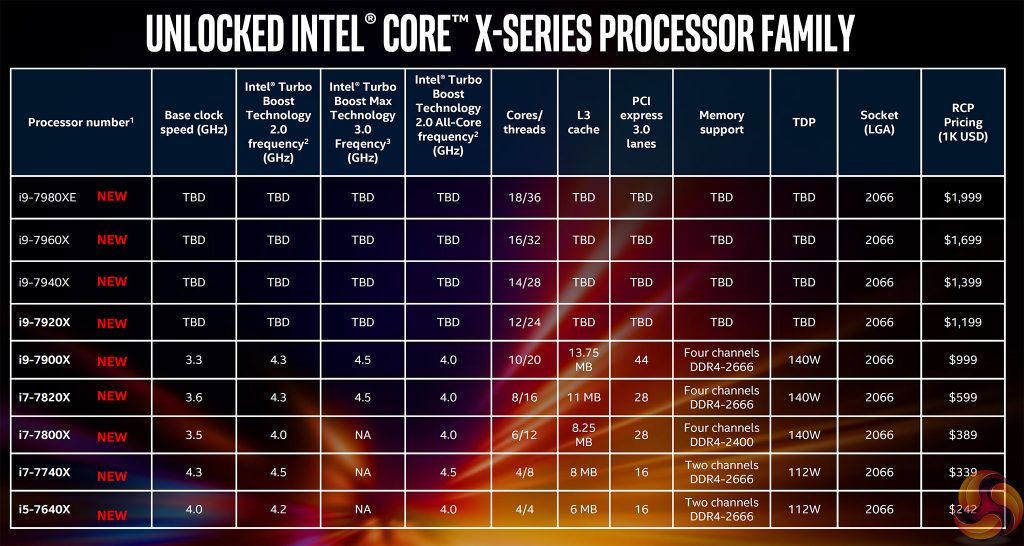
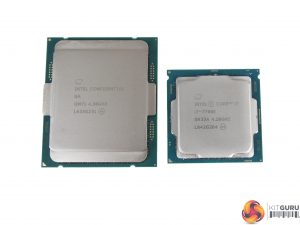
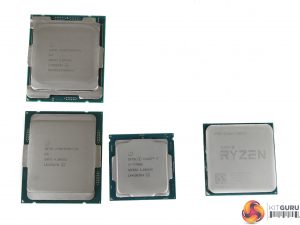
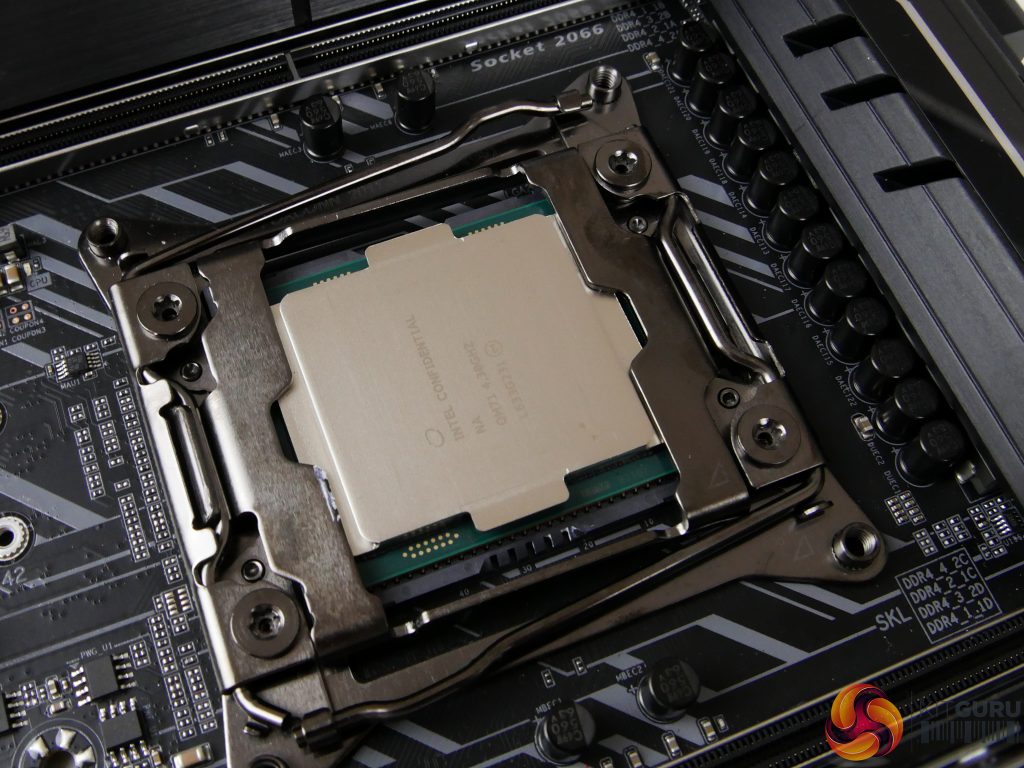
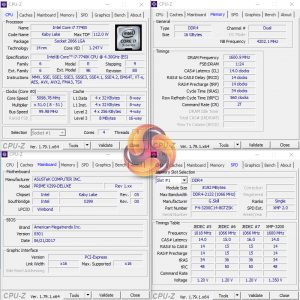
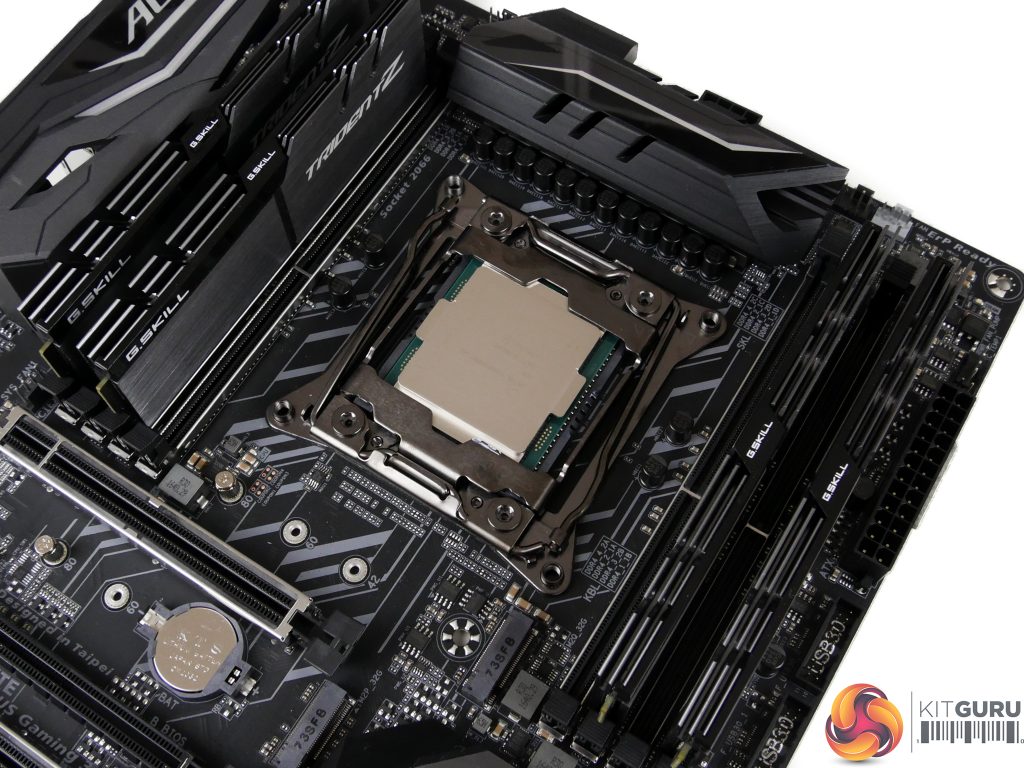
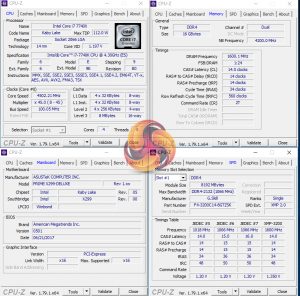
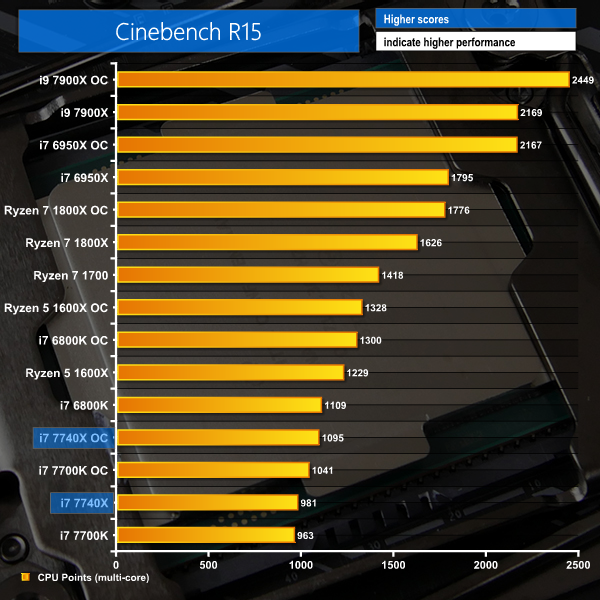
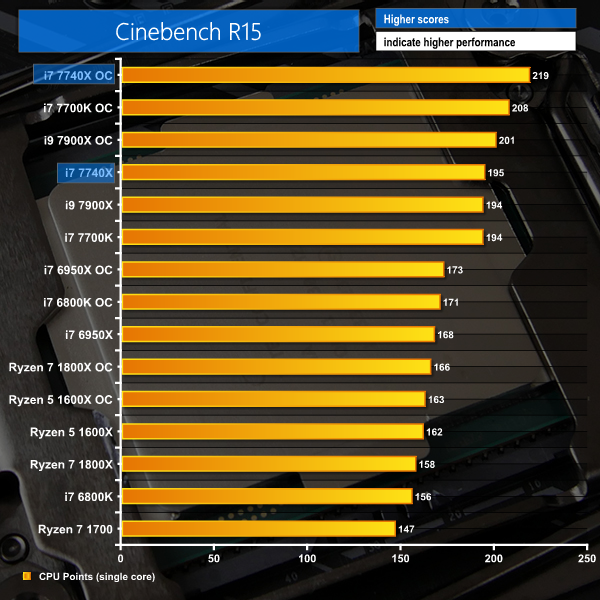
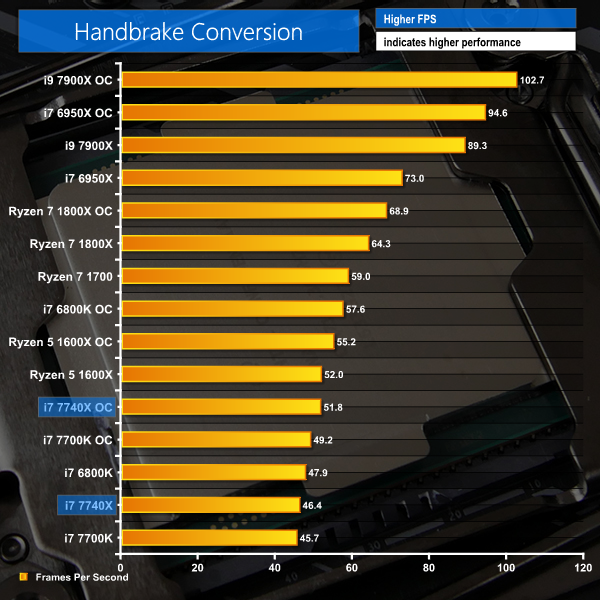
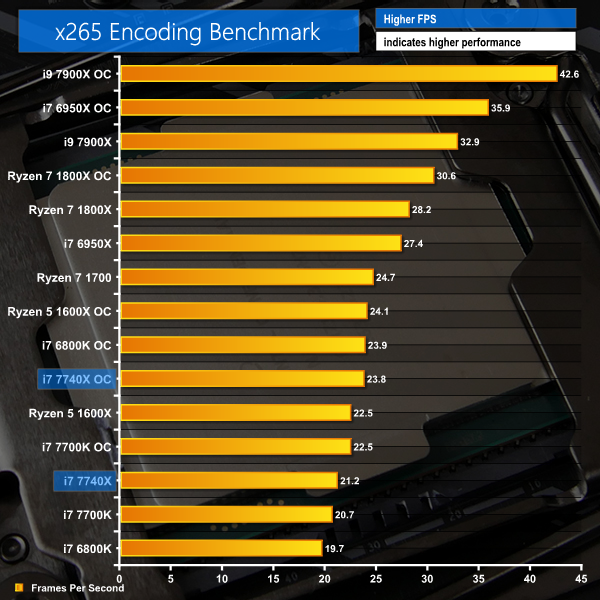
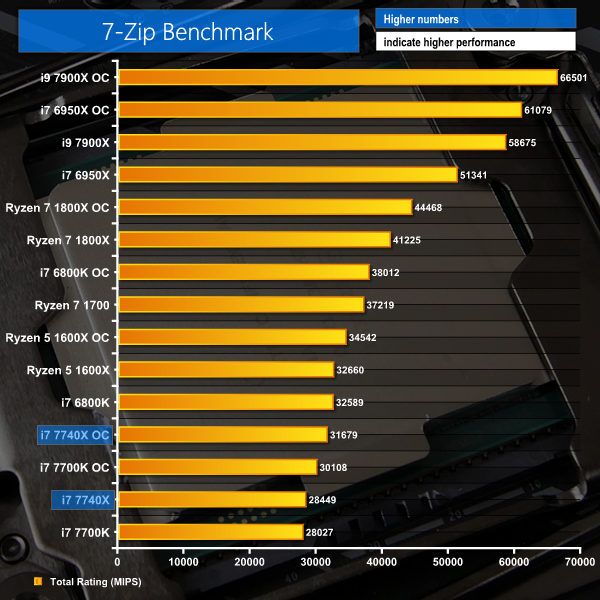
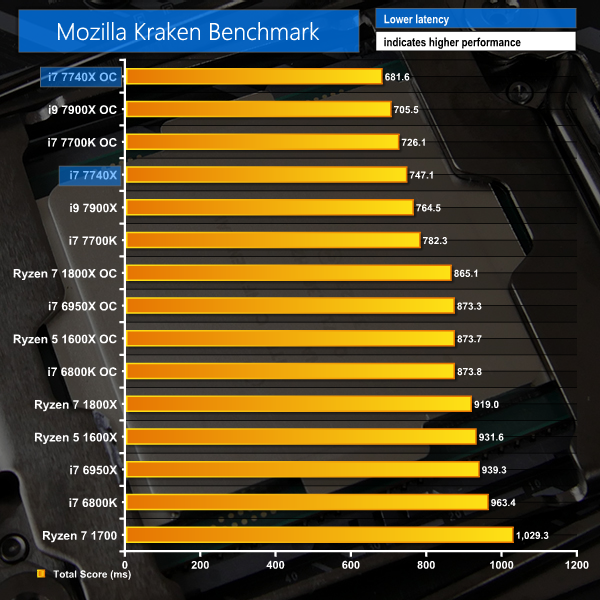
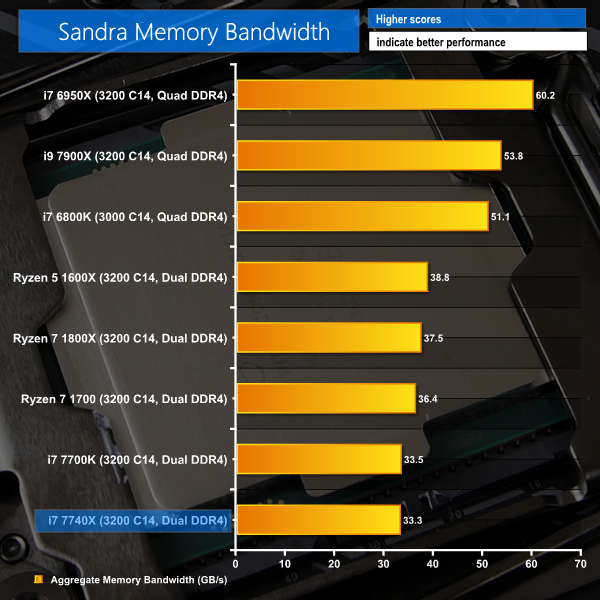
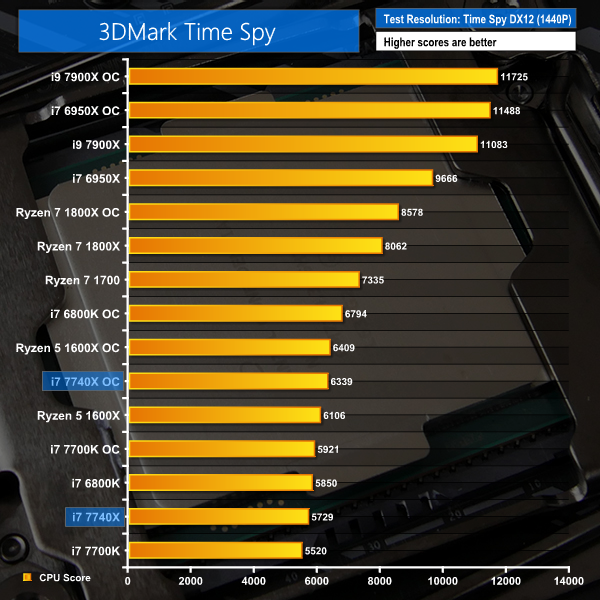




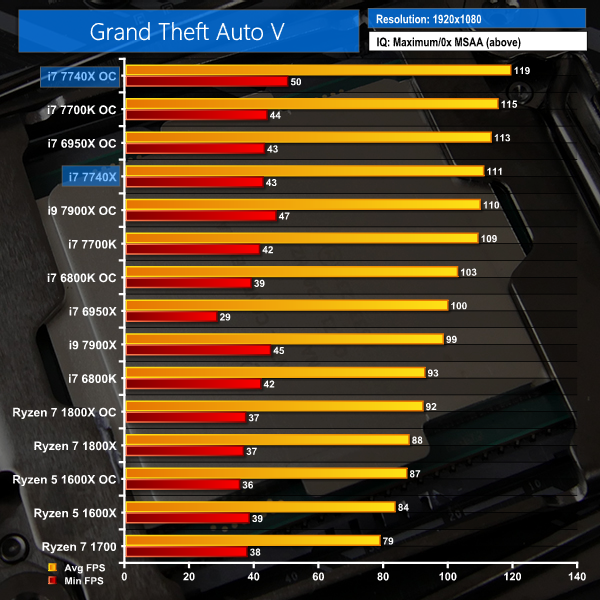
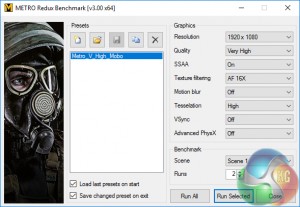


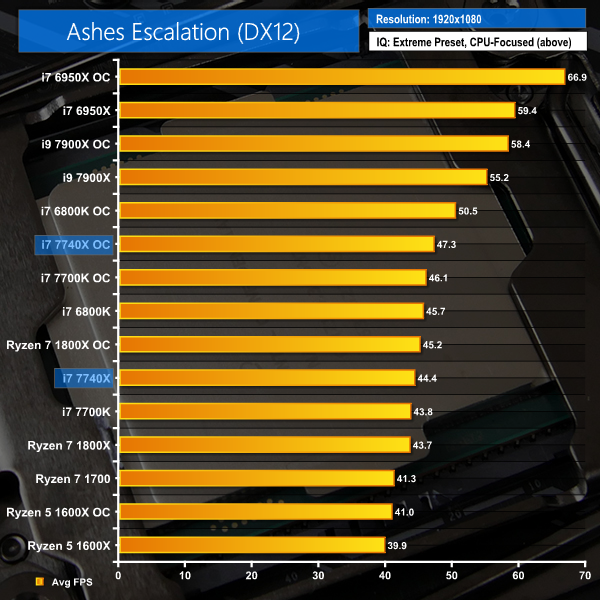

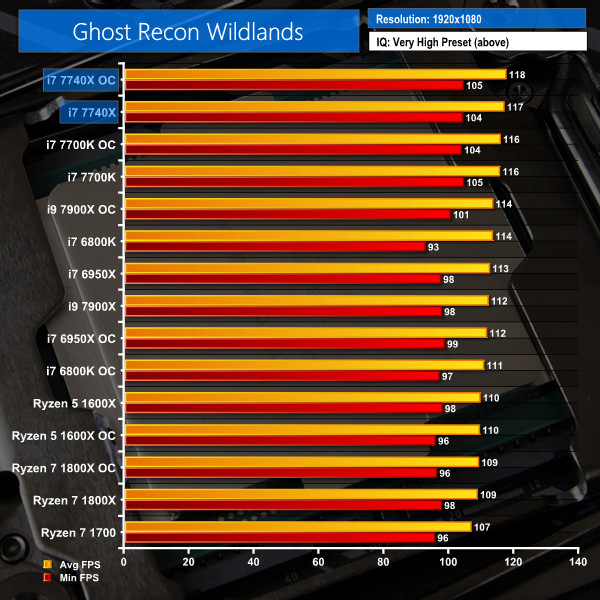


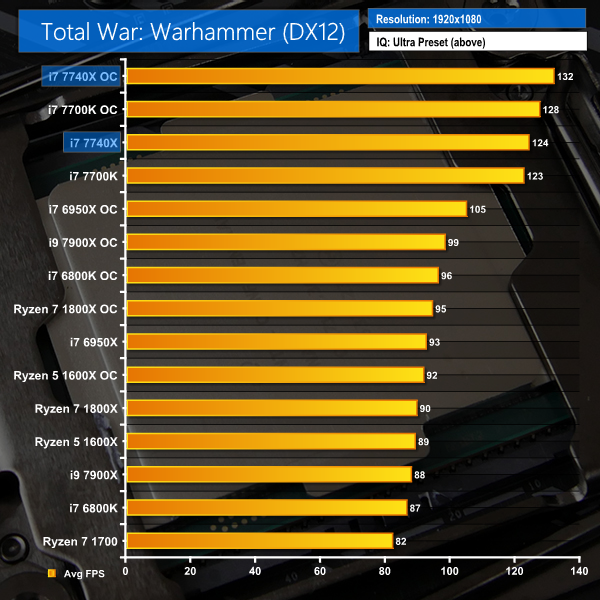
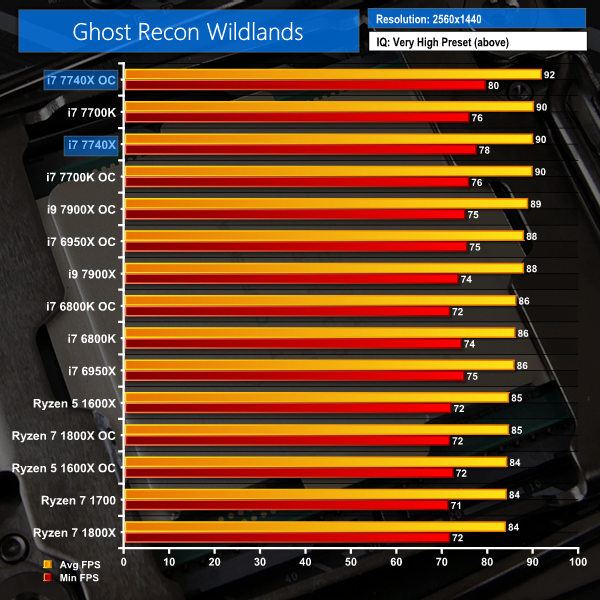
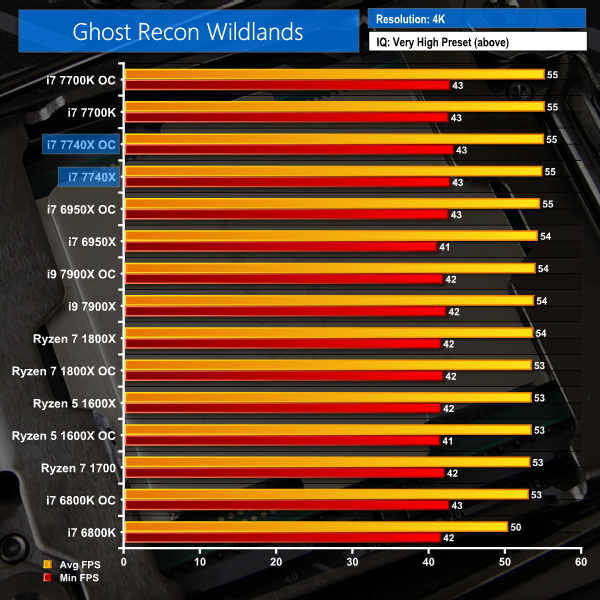




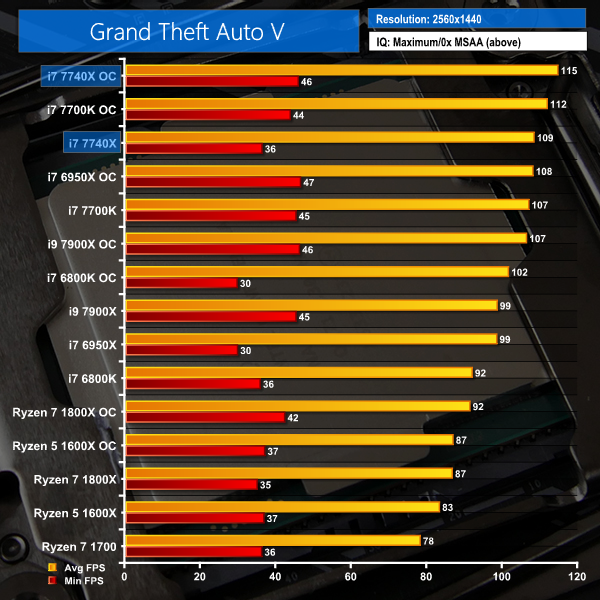
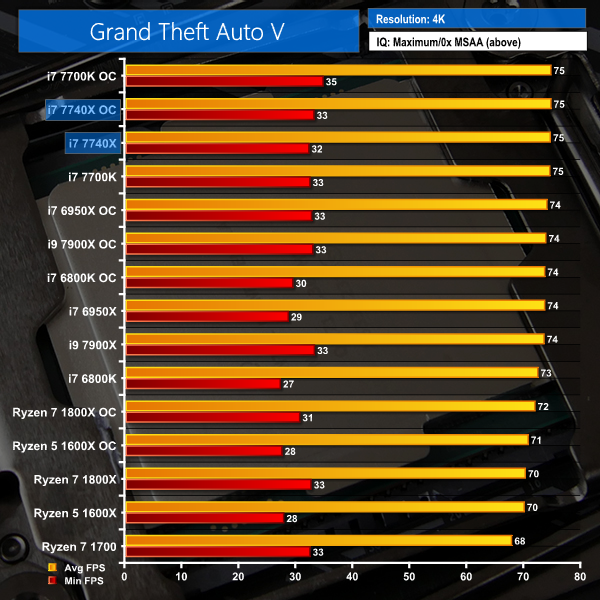

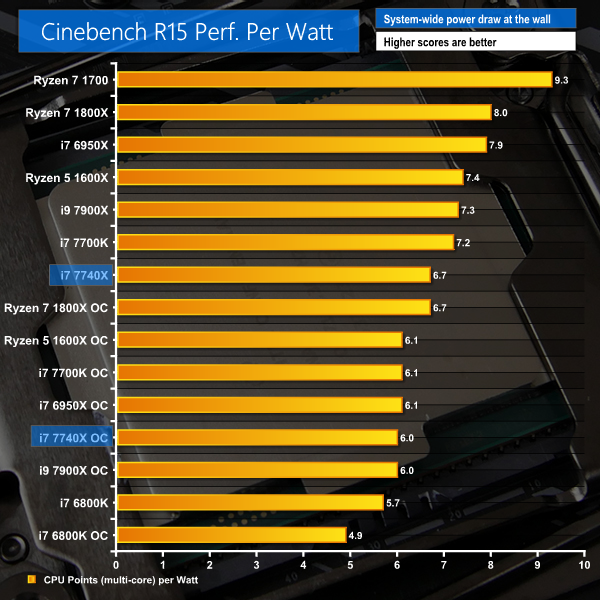

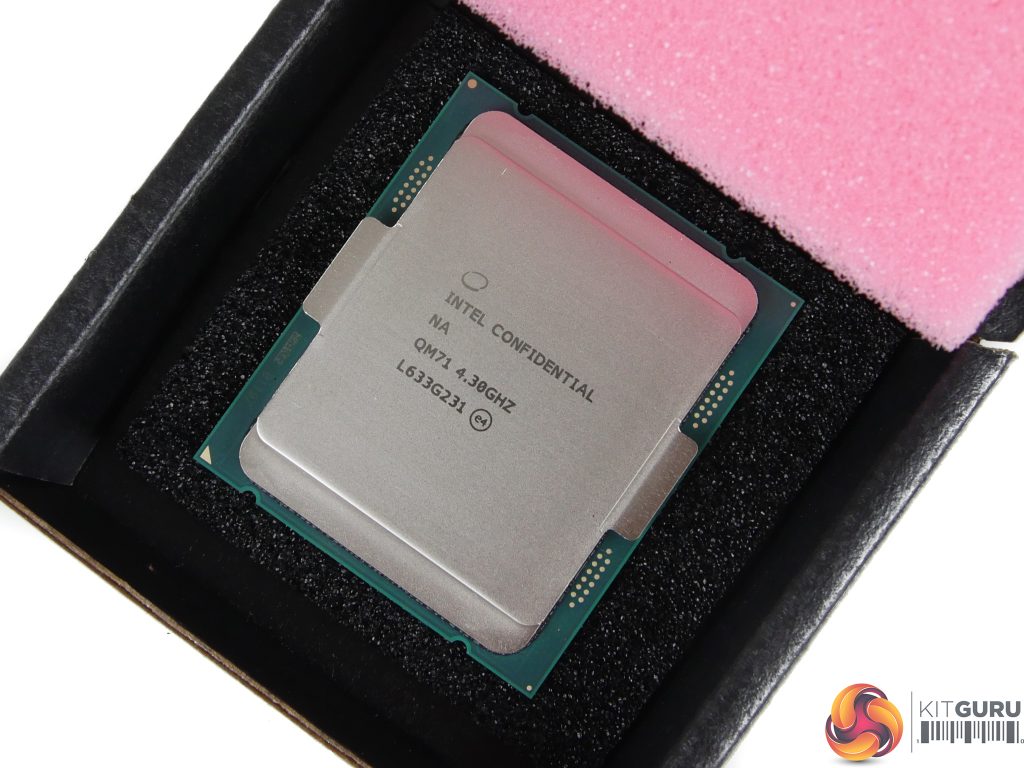
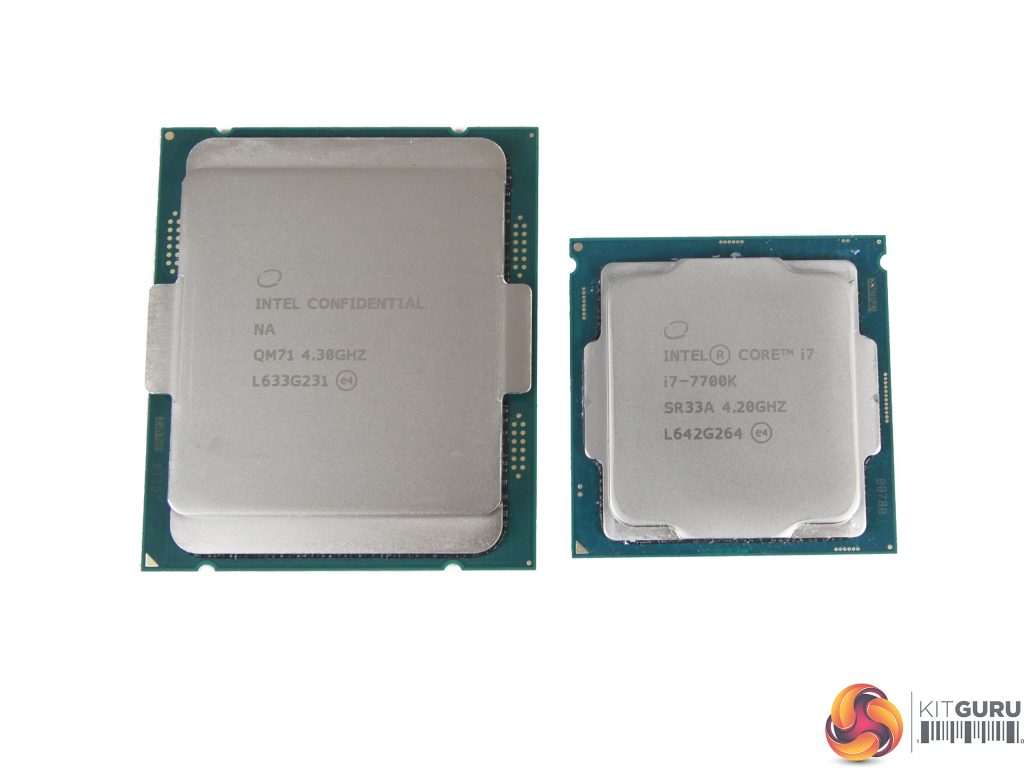


Nice review.
A complete fail from Intel
man i might have to drop kitguru review soon. cant we get a simpler comparison at all these at same frequency? and the power consumption chart simply states 7700k or 7740X and respective “OC” as to what that OC is i’d have to flip back and forth between two browser tabs to your test methodology page.
also im going to assume on power consumption page, the first graph is cinebench? cause the 2nd graph has title says cinebench but first one doesnt..?
finally, if you can please add a drop down menu which page to jump not ONLY at the top of the review but also at the bottom of the review. bottom of the review only has pages to jump to from 1 to 10 and have no idea which is which, making it more work having to guess. power users like to be quick and efficient, was hoping this review be the same.
jobsworth.
Hi. We used to put the speed of the CPU in the chart next to its name but this was taking up a large amount of space on the chart and compressing the data area, making the results more difficult to read. Thanks for the feedback, though, as it shows that there is still adjustment to do for readability improvements on the charts.
Yes, the first chart shows Idle, Cinebench Load, and AIDA 64 stress test power numbers. These are all listed in the key in the bottom-left corner of the chart. That’s normal for charts showing more than one piece of data where the information pertaining to the tests run would not make sense (or fit) in the title.
I much prefer the less cluttered views for the record. But I’ve got a good memory for numbers.